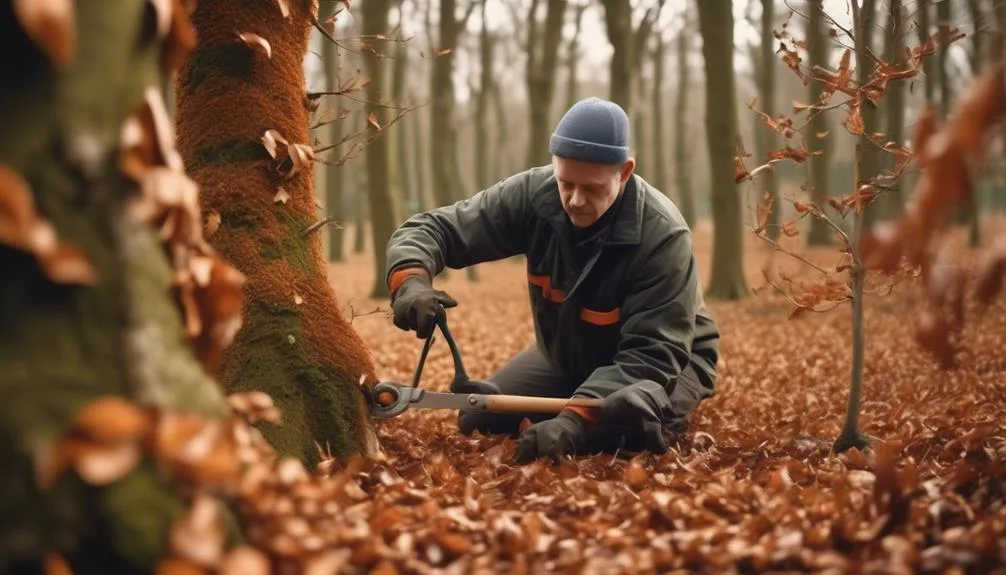Considering adding a majestic beech tree to your landscape? While beech trees can live for over 200 years, caring for them can be quite a task. From pruning and watering to pest management, the care requirements can indeed be demanding.
Let's explore just how high maintenance beech tree care truly is and whether the rewards outweigh the work.
Beech Tree Care Requirements
To ensure the health and vitality of your beech trees, regular watering, proper pruning, and timely fertilization are essential.
When it comes to soil composition, beech trees thrive in well-drained, slightly acidic soils. Heavy clay soils should be amended with organic matter to improve drainage.
Additionally, ensuring adequate sunlight exposure is crucial for the optimal growth of beech trees. They prefer partial to full sunlight, so it's important to plant them in a location where they'll receive at least 4-6 hours of direct sunlight per day.
Properly preparing the soil and selecting an appropriate site for planting will greatly contribute to the overall health and resilience of your beech trees.
Pruning and Trimming Beech Trees
Ensuring the health and vitality of your beech trees involves regular pruning and trimming to promote optimal growth and maintain their stunning appearance. When pruning and trimming your beech trees, it's essential to consider their growth patterns and employ appropriate pruning techniques. Here are some key points to keep in mind:
- Selective Pruning: Identify and remove any dead, diseased, or crossing branches to enhance air circulation and minimize the risk of pest infestations.
- Crown Thinning: Carefully thin out the interior branches to allow for better light penetration and air movement within the canopy, promoting overall tree health.
- Shape Maintenance: Trim the outer growth to maintain a balanced and attractive form, ensuring that your beech trees remain a striking focal point in your landscape.
Watering and Fertilizing Beech Trees
Maintaining the health and vigor of your beech trees requires thoughtful watering and fertilization practices to support their growth and resilience.
Soil testing is crucial to understand the specific needs of your beech trees. Conduct a soil test to determine the pH level and nutrient deficiencies, enabling you to tailor your fertilization approach.
When watering, ensure deep, infrequent watering to encourage deep root growth and drought tolerance.
Mulching techniques can help conserve soil moisture, regulate soil temperature, and suppress weed growth. Apply a 2 to 4-inch layer of organic mulch around the base of the tree, keeping it a few inches away from the trunk to prevent rot.
In addition, consider using slow-release fertilizers to provide a steady nutrient supply over time, promoting healthy, strong beech trees.
Pest and Disease Management for Beech Trees
When managing pests and diseases for your beech trees, it's essential to regularly inspect the foliage and bark for signs of infestation or illness. Integrated pest and disease control is crucial for the health of your trees.
Here's what you can do to maintain the well-being of your beech trees:
- Pruning: Regularly remove dead or diseased branches to prevent the spread of pests and diseases.
- Soil Management: Ensure proper drainage and avoid over-fertilization to prevent root rot and other soil-borne diseases.
- Monitoring: Keep an eye out for common beech tree pests such as scale insects and beech blight aphids, and promptly address any issues.
Seasonal Maintenance for Beech Trees
As you inspect your beech trees for signs of pests and diseases, it's important to understand the specific seasonal maintenance tasks that will keep them healthy and thriving throughout the year.
Implementing a proper fertilization schedule is crucial for beech tree care. In early spring, apply a balanced slow-release fertilizer to provide essential nutrients for healthy growth.
Additionally, consider using a layer of organic mulch around the base of the tree to help retain moisture and promote soil health.
As winter approaches, it's essential to employ winter protection techniques. Consider wrapping the trunks with tree wrap to prevent sunscald and frost cracks during cold months.
Also, ensure that the trees are adequately watered before the ground freezes to help them withstand the winter stress.
Following these seasonal maintenance tasks will help ensure the well-being of your beech trees year-round.
Conclusion
Incorporating regular pruning, proper watering and fertilizing, and pest and disease management is essential for maintaining healthy beech trees.
While some attention is required, the overall maintenance of beech trees is manageable, allowing for their beauty to enhance your landscape without overwhelming upkeep.
How do you strike a balance between nurturing nature and managing maintenance?

My interest in trees started when I first saw the giant sequoias in Yosemite.
I was a teenager then, and I remember thinking, “I need to learn more about this.”
That moment stuck with me.
A few years later, I went on to study forestry at Michigan Tech.
Since graduating, I’ve worked in a mix of hands-on tree care and community education.
I’ve spent over ten years helping people understand how to plant, maintain, and protect the trees in their neighborhoods.
I don’t see trees as just part of the landscape.
They are living things that make a real difference in our daily lives.
